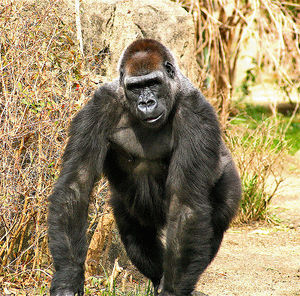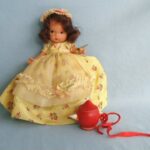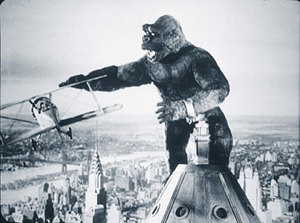The original King Kong movie made in 1933 by Merian Cooper and Ernest Schoedsack is an effective piece of work even when compared to special effects driven modern films. The sequence I am going to analyze is the sacrificial offering of Ann Darrow played by Fay Wray to Skull Islands King Kong. The sequence comes immediately after Carl Denham and his men realize Ann has been kidnapped from the ship by the local savages. The section ends with Ann tied up awaiting King Kong.
The sequence begins with a dissolve edit from the ship to an establishing extreme long shot of the large wooden gate protecting the local’s village. The music played throughout the scenes is a dramatic score that is completely extra diegetic. The lighting of the gate is primarily key lighting which leaves lots of black space on either side of the gate. There is also very little back light in this shot. The action then cuts to an extreme long shot of Ann Darrow being held on her knees by natives. The following two shots are used to build the tension in the film. Using cuts the shots move closer to Ann. First a long shot, and then a medium long shot. This brings us closer to the action as each shot passes. The lighting for Ann’s shot is key and fill lighting. The last portion has Ann in a one shot. This along with the lighting establishes her as the main character in the scene.
A new shot edited with a cut brings us a medium long shot of a native drummer. It is a group shot with key and a small amount of fill lighting. Although the drummer is clearly seen beating the drum with his hand the extra diegetic music plays over his scene and no drum effects can be heard. A cut brings us to the next segment of natives climbing ladders to the top of the gate. The first is an extreme long shot and the second a long shot. The lighting switches from key to fill. This shows large shadows across the climbing characters. This is effective in creating the look that they are climbing by the light of the large fire torches at the side of the gate. The shot ends with a cut and returns us to the original establishing extreme long shot of the gate. This shows the new addition of men standing on top of the gate and wall. This allows the film makers to cut to a long one shot of the native chief. Despite the lack of information in the shot the previously shown new establishing shot tells us that he is standing atop the wall. The chief, like the men climbing the wall is shown in fill light to show the torches presence. The light also helps to establish a crazed look on the chief’s face using shadows as he uses his long staff to signal the gate is opened. The chiefs shot ends in a cut and returns us to the bottom of the wall where a group medium shot shows natives dancing while in the background the bar is being removed from the gate. This is the first time that high back light is used to show the depth of the wooden bar being removed.
Once the gate is opened we focus back on Ann with a one person medium long shot. The key light is again high to illuminate her. Showing Ann after the opening of the gate indicates that she will be going through the gate, to face whatever is on the other side. From Ann we cut to a medium long shot of the chief at the top of the wall. He again signals ominously to lead Ann to the gate. The following shots are very effective in building the tension of the film. We return to a long shot of the establishing scene, this time using stronger key lighting Ann can be seen being led to the gate. Rather than cut to the next scene the camera is mounted on a track and begins to follow Ann towards gate. The shot remains a long shot as Ann is walking away from the camera. The action then cuts to the opposite side of Ann. The camera is no longer on a track. Ann is walking towards the camera for a long shot. Key lighting illuminates Ann as she approaches the camera leaving large amounts of shadow all around her. The angle then returns to a long shot from behind. Again the camera is stationary. This helps the narrative move along as we watch Ann getting further and further away from us.
Once Ann is through the gate we have a shot-return shot sequence of Ann front and back. The medium long shot from front and back has Ann and two natives. The light switches from key lighting on her face to the fill lighting supposedly the fire torches when we see her from behind. The back light is missing again casting uncertain darkness behind her. This ends with a medium long shot from the front of Ann’s arms being tied to two trees. The final shot of the sequence is a medium shot of Ann tied up. This is the closest shot in the sequence. Key, fill and back lighting is all present as we see Ann’s face but also the characters in the background with depth perception.
Although there is no speech in the scene the extra diegetic music that pays throughout the scene is suitable as audio to portray the emotion of the scene. The ominous tones used in the musical piece indicate that Denham and his men will not reach Ann before she is offered to Kong. Certain visual portrayals in the sequence could have been added to further the suspense. The banging of the drum to summon Kong, and the removal of the large wooden bar to open the gate being two examples.
The lighting is effective in setting the scene of a tribal village at night with limited sources of light. The lighting while causing tension from the deep shadows also draws us into Skull Island. We see the changes in light due to the number and placement of torches. The narrative is also moved very clear by the use of lights. Ann Darrow is obviously the most important character in the scene. She is shot with heavy key lights to make her stand out not just in medium shots but also in long group shots.
The editing of the sequence is primarily done using cuts. The exception is the opening establishing shot. This uses a dissolve from Denham’s ship. This portrays the fact that the ceremony to summon Kong is already underway, as they are just leaving the ship. This furthers the belief that they will not reach Ann before Kong. The camera shots of the sequence are mostly done in the longer shots. There are not close up shots of any of the characters. This does a good job at showing all of the natives and how they outnumber not only Denham’s men but at this particular point Ann. The sequence illustrates the excellent techniques used by Cooper and Schoedsack to produce a film that stands the test of time and is as dramatic and emotion producing today as it was in 1933.



